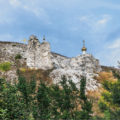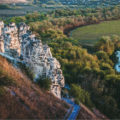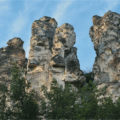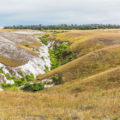The Divnogorye Historical and Cultural Complex in the Voronezh region has been included in the preliminary UNESCO World Heritage List.
In July a long-awaited update appeared on the website of the World Heritage Center: one more Russian contender was added to the preliminary list. Divnogorye became the 26th item in our country to be put on this waiting list.
Divnogorye received the status of a natural, architectural and archaeological museum-reserve almost 30 years ago. In 2015 the former managers of the complex Marina Lylova and Sophia Kondratyeva proposed an initiative to include the complex in the World Heritage List. The formal application was prepared by the museum-reserve with the scientific and methodological support of the Russian Research Institute of Cultural and Natural Heritage named after Dmitry Likhachev (Institute of Heritage).
In 2018 and 2019, the application passed through the domestic process of standardization with the Ministry of Culture of Russia and the National Committee of International Council on Monuments and Sites (ICOMOS), Russia. In 2020 at a meeting of the Council of the National Committee of ICOMOS, the application was unanimously supported by the experts and then sent to the World Heritage Center.
“The members of the Council noted the unique historical and aesthetic value of the cultural landscape of Divnogorye and its unquestionable potential for promotion to the World Heritage List,” said Nadezhda Filatova, the head of the World Heritage and International Cooperation Department of the Heritage Institute, member of the Council of the National Committee of ICOMOS, Russia.
These were the steps that needed to be taken in order to include Divnogorye in the preliminary list. Today the Heritage Institute together with the Museum-Reserve is working on a nomination dossier and a management plan for the Divnogorye Historical and Cultural Complex. These preparations should be completed in 2021, becoming the basis for the application to the main UNESCO World Heritage List.
The symbiosis of man and nature
As the Deputy Head of the Department of World Heritage and International Cooperation of the Institute of Heritage Nargiz Aituganova said at the XIX All-Russian Congress of Bodies of Preservation of Historical and Cultural Monuments, it is clearly seen how in Divnogorye the surrounding nature was used by man from primitive times to the present day. And it shows one of the trends in world heritage conservation: cultural landscapes.
Today Divnogorye, located 80 kilometers south of Voronezh, is an open-air museum. It is a place where a resident of the metropolis can spend some time alone in the pristine nature and get acquainted with the ancient history of the region. There are preserved Bronze Age mounds, sites, and places used for driven hunting by a primitive man in Divnogorye. And next to them there are early medieval Khazar buildings and Christian cave churches. It is a “layer cake” of history, culture, and religion, everything going hand in hand with nature.
The area got its name from the “divas”, remnants of chalk pillars. They rise above the river valleys, creating a unique landscape. Unique natural and cultural symbiosis that fully reflects the important stages of the historical development of the region has been formed here.
The landscapes of Divnogorye are composed from steep slopes of river banks, gullies and ravines, consisting of countless chalk walls, outcrops, canyon-like gorges, and karstic landforms. For millennia, they have provided shelter and sanctuary to people. The dominant landscape types, which encircle the views and panoramas of Divnogorye, are colorful in all seasons. In addition, Divnogorye is notable because of the low impact that anthropogenic changes have had on the area.
The complex covers over 17,000 hectares. At the heart of Divnogorye lie the shared river valley of the Don and Tikhaya Sosna rivers, the interfluvial plateau of these rivers and the villages of Liski and Krinitsa, which form unique massive headland, cut by ravines. The buffer zone of Divnogorye includes the adjacent areas along the left bank of the Don River, along the Tikhaya Sosna River in the vicinity of the Uspenskoe settlement, and along the Liski-Pukhovo railway line.
Six monuments
The most striking Paleolithic monument of this area is “Divnogorye site 9”, the dying grounds of ancient horses. This is a unique monument of the late Paleolithic era that is estimated to be from 13 to 14 thousand years old, which has the world’s largest find of complete skeletons of the terminal Pleistocene horses. Along with the dying grounds, there is a large group of outstanding archaeological sites that tell the continuous history of human existence in the area of Divnogorye up to the early Middle Ages, when these lands became part of the Khazar Kaganate. These are the settlement of Tikhaya Sosna of the Mesolithic era, the site of the Ustye Sosny of the Neolithic era of the Bronze Age, a group of mounds from the Bronze Age, located near the villages of Selyavnoye and Krinichanskaya, another group of mounds near the archaeological park, a mound near the potters’ farm of the Mayatsky archaeological complex, and the settlements of Golaya Balka and Selyavnoye of the early Iron Age.
The Khazar fortified settlement, called the Mayatsky archaeological complex, refers to the IX — early X centuries and it is a classic monument of the Saltovo-Mayatsk archaeological culture, which includes a city settlement, a village settlement, a burial ground and a craft complex, the so-called “pottery farm”. This is the best-preserved and thoroughly studied and detailed monument of the Khazar Kaganate, a disappeared сгдегку, which at one time competed with Rus, Byzantium, and the Arab Caliphate. The Mayatskaya Fortress was built on a picturesque headland from chalk blocks, on which more than 400 drawings, inscriptions, and symbols were found during archeological research.
The key elements that form the recognizable image of Divnogorye, along with the Mayatskaya fortress, are individual groups of chalk outcrops: Bolshiye Divy, Malye Divy, Shatrishche Mount and Selyavinskaya ridge with its cave church complexes.
There are six cult caves and cave complexes in the area. All of them were cut from the chalk massive on the right bank of the Tikhaya Sosna and Don rivers along a section about 8.5 km long. The complexes include cave churches and chapels, utility rooms, cells, crypts, and long galleries. The smallest cave is only 27 meters long and the largest is 351 meters long.
The museum-reserve sees its mission in telling and showing that in all historical epochs every person is a part of the natural world, and nature is a fundamental condition for the existence of human society. This idea is not only consonant with the spirit of Divnogorye itself but also matches modern trends in the field of UNESCO World Heritage.
Maria Ermakova, press secretary of the Institute of Cultural and Natural Heritage named after Dmitry Likhachev




